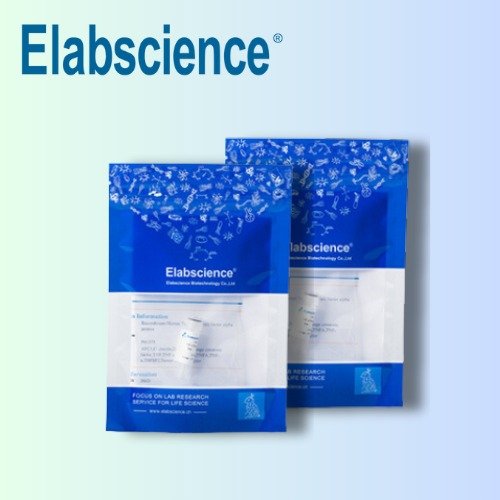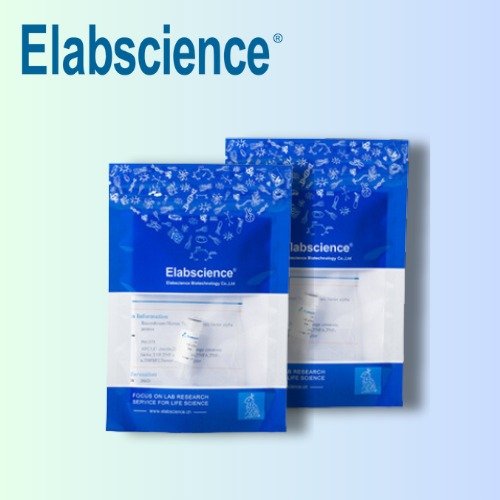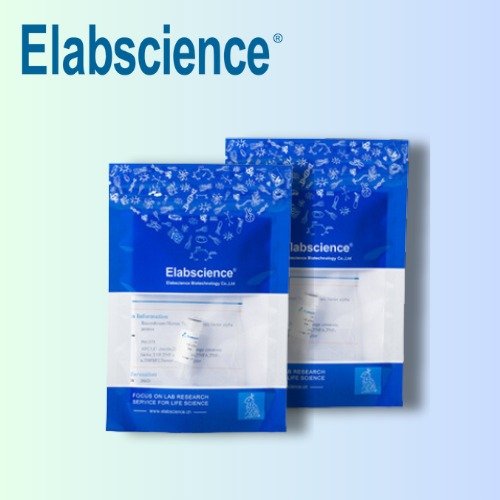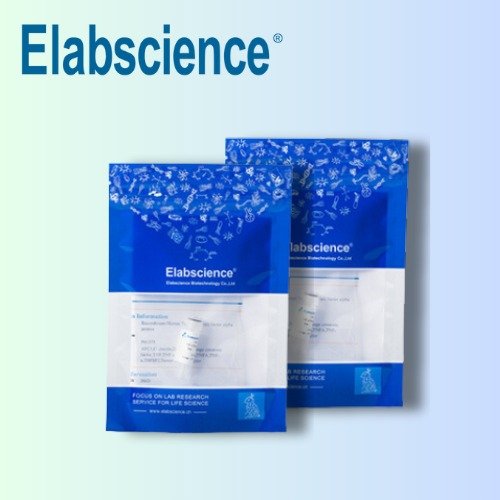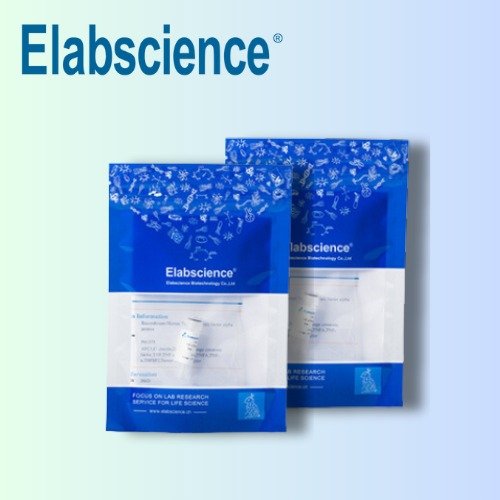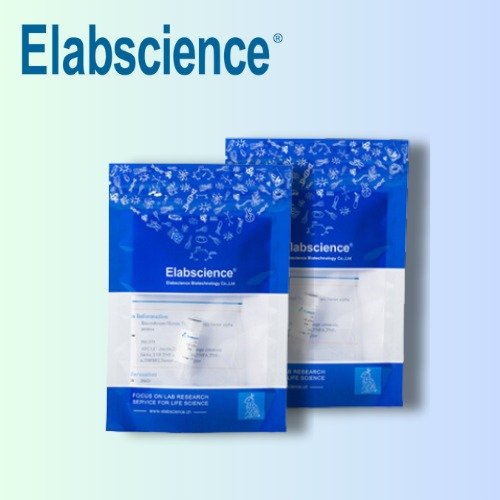Elabscience Protein
Elabscience Protein
Manufacturer: Elabscience
TNFα is a homotrimer with a subunit molecular mass of 17 kD cytokine that binds to TNFRSF1A/TNFR1 and TNFRSF1B/TNFBR. It is mainly secreted by macrophages and can induce cell death of certain tumor cell lines. It plays a major role in growth regulation; differentiation; inflammation; viral replication; tumorigenesis; autoimmune diseases and in viral; bacterial; fungal; and parasitic infections. Besides inducing hemorrhagic necrosis of tumors; TNF was found to be involved in tumorigenesis; tumor metastasis; viral replication; septic shock; fever; inflammation; and autoimmune diseases including Crohn’s disease; and rheumatoid arthritis as well as graft-versus-host disease.
Manufacturer: Elabscience
Transforming Growth Factor β-1 (TGFβ-1) is a secreted protein which belongs to the TGF-β family. TGFβ-1 is abundantly expressed in bone; articular cartilage and chondrocytes and is increased in osteoarthritis (OA). TGFβ-1 performs many cellular functions; including the control of cell growth; cell proliferation; cell differentiation and apoptosis. The precursor is cleaved into a latency-associated peptide (LAP) and a mature TGFβ-1 peptide. TGFβ-1 may also form heterodimers with other TGFβ family members. It has been found that TGFβ-1 is frequently upregulated in tumor cells. Mutations in this gene results in Camurati-Engelmann disease.
Manufacturer: Elabscience
Tau proteins are proteins which contain four Tau/MAP repeats. They promote microtubule assembly and stability, and might be involved in the establishment and maintenance of neuronal polarity. They are abundant in neurons of the central nervous system and are less common elsewhere, but are also expressed at very low levels in CNS astrocytes and oligodendrocytes. The tau proteins are the product of alternative splicing from a single gene that in humans is designated MAPT. When tau proteins are defective, and no longer stabilize microtubules properly, they can result in several neurodegenerative disorders such as Alzheimer's disease, Pick's disease, frontotemporal dementia, cortico-basal degeneration and progressive supranuclear palsy.
Manufacturer: Elabscience
Signal Transducer and Activator of Transcription 3 (STAT3) belongs to the transcription factor STAT family. STAT3 contains one SH2 domain and is a transcription factor expressed in most cell types. STAT3 is activated by multiple cytokines and growth factors including: IFN-a, IL-10, IL-6, IL-11, IL-12, IL-2, EGF etc.
Manufacturer: Elabscience
Platelet-Derived Growth Factor Subunit B (PDGFB) belongs to the PDGF/VEGF growth factor family. Platelet-derived growth factor is a potent mitogen for cells of mesenchymal origin. PDGFB can exist either as a homodimer (PDGF-BB) or as a heterodimer with the platelet-derived growth factor alpha polypeptide (PDGF-AB), where the dimers are connected by disulfide bonds. Mutations in this gene are associated with meningioma.Binding of PDGFB to its receptor elicits a variety of cellular responses. In addition, PDGFB is released by platelets upon wounding and plays an important role in stimulating adjacent cells to grow and thereby heals the wound.
Manufacturer: Elabscience
IL-10 is a anti-inflammatory cytokine which belongs to the IL-10 family. It is produced by a variety of cell lines, including T-cells, macrophages, mast cells and other cell types, while it is produced primarily by monocytes and to a lesser extent by lymphocytes. IL-10 is mainly expressed in monocytes and Type 2 T helper cells (TH2), mast cells, CD4+CD25+Foxp3+ regulatory T cells, and also in a certain subset of activated T cells and B cells. IL-10 has pleiotropic effects in immunoregulation and inflammation. It down-regulates the expression of Th1 cytokines, MHC class II Ags, and costimulatory molecules on macrophages. It also enhances B cell survival, proliferation, and antibody production. IL-10 can block NF-kappa B activity, and is involved in the regulation of the JAK-STAT signaling pathway. Knockout studies in mice suggested the function of this cytokine as an essential immunoregulator in the intestinal tract. The importance of interleukin 10 for counteracting excessive immunity in the human body is revealed by the fact that patients with Crohn's disease react favorably towards treatment with bacteria producing recombinant IL-10. IL-10 inhibits the synthesis of a number of cytokines, including IFN-gamma, IL-2, IL-3, TNF and GM-CSF produced by activated macrophages and by helper T-cells. It also displays a potent ability to suppress the antigen-presentation capacity of antigen presenting cells. However, it is also stimulatory towards certain T cells and mast cells and stimulates B cell maturation and antibody production.
Manufacturer: Elabscience
Interleukin-6 (IL-6) is a pleiotropic, alpha -helical, 22-28 kDa phosphorylated and variably glycosylated cytokine that plays important roles in the acute phase reaction, inflammation, hematopoiesis, bone metabolism, and cancer progression. IL-6 induces signaling through a cell surface heterodimeric receptor complex composed of a ligand binding subunit (IL-6 R alpha) and a signal transducing subunit (gp130). IL-6 binds to IL-6 R alpha, triggering IL-6 R alpha association with gp130 and gp130 dimerization. Soluble forms of IL-6 R alpha are generated by both alternative splicing and proteolytic cleavage. In a mechanism known as trans-signaling, complexes of soluble IL-6 and IL-6 R alpha elicit responses from gp130-expressing cells that lack cell surface IL-6 R alpha. Trans-signaling enables a wider range of cell types to respond to IL-6, as the expression of gp130 is ubiquitous, while that of IL-6 R alpha is predominantly restricted to hepatocytes, monocytes, and resting lymphocytes. Soluble splice forms of gp130 block trans-signaling from IL-6/IL-6 R alpha but not from other cytokines that use gp130 as a co-receptor. IL-6, along with TNF-alpha and IL-1, drives the acute inflammatory response and the transition from acute inflammation to either acquired immunity or chronic inflammatory disease. When dysregulated, it contributes to chronic inflammation in obesity, insulin resistance, inflammatory bowel disease, arthritis, sepsis, and atherosclerosis. IL-6 can also function as an anti-inflammatory molecule, as in skeletal muscle where it is secreted in response to exercise.
Manufacturer: Elabscience
IL1B belongs to the IL-1 family. Interleukin 1 (IL-1) is a family of polypeptide cytokines consisting of two agonists, IL-1 alpha (IL-1F1) and IL-1 beta (IL-1F2) encoded by two distinct genes and perform identical biological functions. IL-1 stimulates thymocyte proliferation by inducing IL-2 release, B-cell maturation and proliferation, and fibroblast growth factor activity. IL-1 proteins are involved in the inflammatory response. It is identified as endogenous pyrogens, and is reported to stimulate the release of prostaglandin and collagenase from synovial cells.
Manufacturer: Elabscience
Insulin-like growth factor I (IGF1) belongs to the family of insulin-like growth factors that are structurally homologous to proinsulin. Mature IGFs are generated by proteolytic processing of inactive precursor protein containing N-terminal and C-terminal propeptide regions. Mature human IGF-I consisting of 70 amino acids with 94% identity with mouse IGF1 and exhibits cross-species activity. IGF1 binds IGF-1R; IGF-2R; and the insulin receptor and plays a key role in cell cycle progression; cell proliferation and tumor progression. IGF1 expression is regulated by growth hormone.

